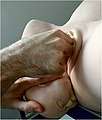Rubin maneuver
Rubin maneuver, also known as reverse Woods maneuver, is a secondary, rotational maneuver to deliver the baby in case of shoulder dystocia.[1] The first Rubin maneuver is the rotation of anterior shoulder under pubic symphysis by giving suprapubic pressure. As a result, the bisacromial diameter is rotated from anteroposterior to oblique lie. The obstetrician uses the right hand for performing this maneuver if the foetus is facing mother's right side, and vice versa. During first Rubin maneuver, fundal pressure should not be applied because it may cause uterine rupture or further impaction of the shoulder. If the first Rubin maneuver does not disengage the shoulder, second Rubin maneuver is performed.
The second Rubin maneuver is performed by inserting one hand vaginally behind the posterior aspect of anterior shoulder of the baby and rotating the shoulder towards the chest of the baby, shifting it from the midline (12 o clock) to 11 o clock or 1 o clock position. As a result, the baby's shoulder girdle is adducted and the diameter is reduced.[2] The second Rubin maneuver is more successful if it is combined with suprapubic pressure to facilitate vaginal rotation. This maneuver is painful and difficult for an unanesthetized mother. For primipara, an episiotomy may be performed before inserting the vaginal hand.[3] The reverse Wood's screw maneuver is the same as second Rubin maneuver except that it is performed on posterior shoulder and the rotation happens on an oblique plane.
The most common complications of Rubin maneuver are clavicular fracture and brachial plexus injury. There is a higher risk of neonatal injury in Rubin maneuver than with the delivery of posterior shoulder.[4]
- Rubin II procedure
 Step 1: Index and middle fingers insertion with the hand opposite the baby's face
Step 1: Index and middle fingers insertion with the hand opposite the baby's face Step 2: Baby's head slightly tilted downward with the free hand
Step 2: Baby's head slightly tilted downward with the free hand Step 3: Two fingers are placed on the humerus like a splint
Step 3: Two fingers are placed on the humerus like a splint Step 4: Baby's hand appears under the maternal pubic symphysis, allowing the anterior arm to be delivered
Step 4: Baby's hand appears under the maternal pubic symphysis, allowing the anterior arm to be delivered
References
- Benrubi, Guy (2010). Handbook of obstetric and gynaecologic emergencies (4 ed.). Philadelphia, PA: Lippincott Williams & Wilkins. pp. 168–69. OCLC 463631861.
- O' Leary, James (2009). Shoulder Dystocia and Birth Injury: Prevention and Treatment. Springer Science and Business Media. p. 96.
- Gruenberg, Bonnie (2008). Birth Emergency Skills Training: Manual for Out-of-hospital Midwives. Duncannon, PA: Birth Guru Publications. p. 227.
- Gabbe, Steven. Obstetrics: Normal and Problem Pregnancies. Elsevier Medical Sciences. p. 390.